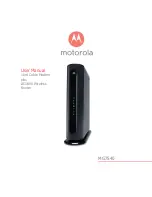
Chapter 2, Advanced Configuration
34
TR-WMX-3.5 Betriebsanleitung für Teilnehmergeräte
Table 2-4. Fields and Buttons in the VLAN Settings Page
Field
Description
VLAN Mode
Lets you enable or disable VLAN mode. Choices are:
•
Enable – enables VLAN mode, enabling the settings on this page.
•
Disable – disables VLAN mode, disabling the settings on this page. (
default
)
VLAN Tag
Tagging refers to the IEEE 802.1Q header that is inserted into the standard Ethernet header.
Choices are:
•
Allow – a Tag Header is added to the frame after the destination and source MAC
addresses. This information is preserved as the frame moves through the network..
(
default
)
•
Drop – a Tag Header is not added to the frame.
Nested VLANs
Nested VLANs (also known as VLAN double tagging) are used to overlay a private Layer 2
network over a public Layer 2 network. This provides simple access to an infrastructure of
network service providers in networks. With a nested VLAN configuration, each customer is
given a customer-ID, which is a unique identifier within the service provider infrastructure.
Traffic from individual customers is tagged with the customer-ID and segregated from other
customer’s traffic.
•
Disable – disables nested VLANs. (
default
)
•
Enable – enables nested VLANs.
Management VLAN ID
The numeric identifier for the management VLAN. Default is 0.
Valid VLAN ID Range
To specify a range of VLAN IDs, enter the first and last numbers, separated by a dash (for
example, 100-200). Default is 0.
VLAN Default
The default ID and priority of the VLAN. Defaults are 0 for ID and Priority.
Set Specific VLAN Rules
VLAN Rule ID
You can create a VLAN identification matching rule that is based on a single VLAN ID or
priority, a range of IDs or priorities, or any ID or priority.
Priority
Specify a single VLAN priority, a range of VLAN priorities, or a VLAN priority for any traffic
flow.
•
To specify a single VLAN priority, enter a number between 0 and 7 (0 has the highest
priority and 7 has the lowest priority).
•
To specify a range of VLAN priorities, enter the first and last numbers, separated by a
dash (for example, 1-3).
•
To match any traffic flow that has a VLAN priority tag, type the word
any
.
Active
Select whether the rule is enabled or disabled. Choices are:
•
Disable – rule is not in effect.
•
Enable – rule is in effect.
VLAN ID
Enter the VLAN ID of the rule you want to edit or delete.
Source MAC Range
The range of source MAC addresses to which the rule applies and corresponding mask.
Destination MAC Range
The range of destination MAC addresses to which the rule applies and corresponding mask.
















































